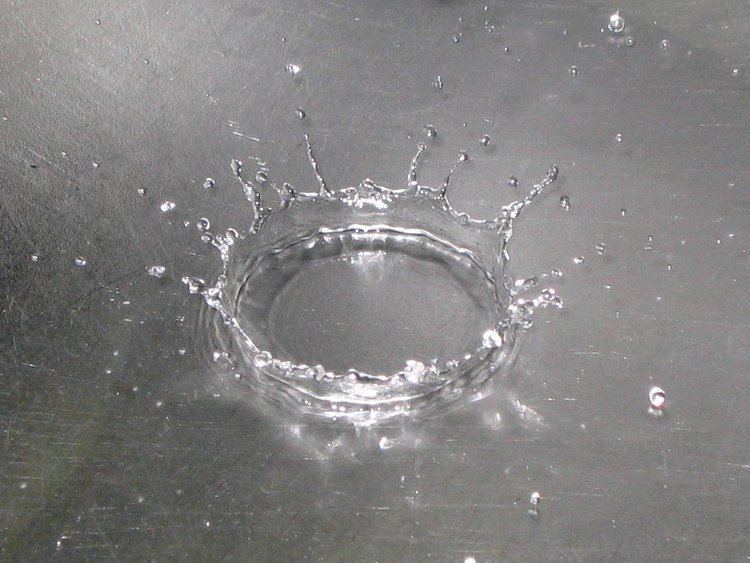 | ||
Drop impact occurs when a liquid drop strikes a solid or liquid surface. The resulting outcome depends on the properties of the drop, the surface, and the surrounding fluid, which is most commonly a gas.
Contents
Drop impact on a dry solid surface
When a liquid drop impacts a dry solid surface, it generally spreads on the surface, and then will retract if the impact is energetic enough to cause the drop to spread out more that it would generally spread due to its static receding contact angle. The specific outcome of the impact depends mostly upon the drop size, velocity, surface tension, viscosity, and also upon the surface roughness and the contact angle between the drop and the surface.
Summary of possible drop impact outcomes
Small drop deformation
On superhydrophobic surfaces, liquid drops are observed to bounce off of the solid surface. Richard and Quéré showed that a small liquid drop was able to bounce off of a solid surface over 20 times before coming to rest. Of particular interest is the length of time that the drop remains in contact with the solid surface. This is important in applications such as heat transfer and aircraft icing. To find a relationship between drop size and contact time for low Weber number impacts (We << 1) on superhydrophobic surfaces (which experience little deformation), a simple balance between inertia (
where
This yields
The contact time is independent of velocity in this regime. The minimum contact time for a low deformation drop (We << 1) is approximated by the lowest-order oscillation period for a spherical drop., giving the characteristic time a prefactor of approximately 2.2. For large-deformation drops (We > 1), similar contact times are seen even though dynamics of impact are different, as discussed below. If the droplet is split into multiple droplets, the contact time is reduced.
By creating tapered surfaces with large spacing, the impacting droplet will exhibit the counterintuitive pancake bouncing, characterized by the droplet bouncing off at the end of spreading without retraction, resulting in ~80% contact time reduction.
Significant drop deformation
As the Weber number increases, the drop deformation upon impact also increases. The drop deformation pattern can be split up into regimes based on the Weber number.
Drop impact on a wet solid surface
When a liquid drop impacts a wet solid surface (a surface covered with a thin layer of liquid that exceeds the height of surface roughness), either spreading or splashing will occur. If the velocity is below a critical value, the liquid will spread on the surface, similar to deposition described above. If the velocity exceeds the critical velocity, splashing will occur. Splashing on thin fluid films occurs in the form of a corona, similar to that seen for dry solid surfaces. Under proper conditions, droplet hitting on a liquid interface can also display a superhydrophobic-like bouncing, characterized by the contact time, spreading dynamics and restitution coefficient independent of the underlying liquid properties.
Drop impact on a liquid surface
When a liquid drop impacts the surface of a liquid reservoir, it will either float, bounce, coalesce with the liquid reservoir, or splash. In the case of floating, a drop will float on the surface for several seconds. Cleanliness of the liquid surface is reportedly very important in the ability of drops to float. Drop bouncing can occur on perturbed liquid surfaces. If the drop is able to rupture a thin film of gas separating it from the liquid reservoir, it can coalesce. Finally, higher Weber number drop impacts (with greater energy) produce splashing. In the splashing regime, the impacting drop creates a crater in the fluid surface, followed by a crown around the crater. Additionally, a central jet, called the "Rayleigh jet," or "Worthington jet" protrudes from the center of the crater. If the impact energy is high enough, the jet rises to the point where it pinches off, sending one or more droplets upward out of the surface.
